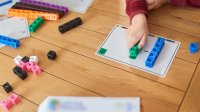Making the Most of Math Intervention Blocks
Intervention blocks don’t have to be rote review—this format based on computation practice and games can boost engagement and learning.
Your content has been saved!
Go to My Saved Content.Every child can learn math well. Through a Multi-Tiered System of Support (MTSS), teachers can design a learning environment that allows every child to learn and thrive. An MTSS ensures that every child is meaningfully included in grade-level learning, while some children receive additional layers of instruction (intervention, extension, re-teaching) to meet their needs.
Identify priority concepts
When providing that second or third layer of instruction (Tier 2 and Tier 3) through a math-focused intervention, teachers sometimes think this translates into repeating the main lesson “louder and slower,” or rote practice of procedures without conceptual understanding. A quality math intervention block should include a clear, manageable goal focused on the prioritized math content. This can include engaging activities like number sense routines, games, and problem-solving practice, as well as high-quality tasks that require reasoning and sense making.
All Learners Network, an organization that promotes math equity and inclusion for all students, identifies high leverage concepts, progressions, and assessments at each grade level. These are the key mathematical understandings at each grade level from pre-K to eighth grade that help focus instruction by identifying the mathematical ideas that will support students’ access to grade-level content the following year.
Classroom teachers, special educators, and interventionists use the concepts, progressions, and assessments to identify the most meaningful areas for focus during specialized instruction and intervention. A quality Tier 2 or Tier 3 intervention takes into account students’ misconceptions and incomplete understanding from previous grade levels and focuses time spent with students on essential understanding that will close the gap toward the current grade level’s concepts.
Designing a Math Block that Works
Student engagement opens the door to learning: Students need to feel that the learning opportunities provided for them are authentic, relevant, and rigorous. When teachers believe that all students can achieve high levels of mathematics, students will rise to that challenge. This is especially important during a 30-minute math intervention block. Students should have the opportunity to communicate their thinking, compare their thinking with others’, and support their understanding through exploration of concrete models moving to more abstract representations.
Here is one way to structure a math intervention block to keep students engaged throughout.
Launch/number sense routine (5 minutes): Launch is a welcoming, inclusive activity that is intended for purposeful, discussion-rich learning opportunities. The launch should be engaging, relevant, and open-ended enough that all students can participate. Launch/number sense routines build flexibility with numbers and deepen understanding of operations.
Some resources for this include Notice and Wonder, Which One Doesn’t Belong, Would You Rather Math, Splat!, and Visual Images, Estimation, Reasoning, and Number Strings.
Computation practice and strategy share (10–15 minutes): Computation practice is an opportunity for students to practice with operations. Students need to practice strategies they’ve been taught while also practicing and discussing other strategies in a small group setting. Students should solve problems, share and model strategies, and then connect their models and representations to other, potentially more complex or abstract, models and representations.
Some resources include YouCubed tasks, Open Middle, Numberless Word Problems, and Three Act Tasks for elementary, middle, and high school.
Game (10 minutes): Playing games is an engaging way to allow students to think strategically while reinforcing the math concepts they are learning in a different context. Students solidify their understanding of a concept in far fewer repetitions through game play compared with rote practice. In the act of play, students are able to think freely and play with these mathematical concepts in a low-pressure environment.
You might already have games that are part of your math program, or games that you have at home, like Mancala or a Set card game. Other options include Marilyn Burns Math games and YouCubed dice games.
Closure (5 minutes): Finally, plan closure activities that clearly revisit the purpose for the intervention and allow students to self-monitor progress. Closure is one of the most important yet often forgotten components of a math lesson. As part of an intervention block, closure allows students to summarize their thinking, connect back to the clear learning goal for their intervention, and evaluate their progress toward mastery. Closure can be part of a wrap-up activity as students are cleaning up or as they walk back to class. Some prompts to consider as part of the closure include:
- I understand that we are working toward…
- A new strategy I now get is…
- Something I’m still thinking about is…
- I’m wondering about…
- This is like what I did in math class because…
This type of structure gives us the opportunity to consider the instructional design of our additional layers of instruction. Students need additional opportunities to explore a mathematical concept, engage in dialogue with their peers, and connect their small group instruction back to the work they are doing in their main lesson.
